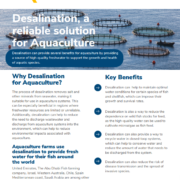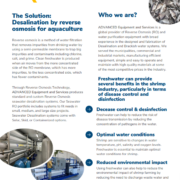Aquaculture & Reverse Osmosis Systems
In the world of aquaculture, sustainability and technology are key. With growing demand for seafood, operations in aquaculture face the challenge of supplying water with a high purity level for the proper development and wellness of aquatic species. Reverse osmosis (RO) technology is a powerful tool, providing high-purity water for application in aquaculture.
How Reverse Osmosis Works in Aquaculture
Reverse osmosis is a water purification process that uses a semi-permeable membrane to remove impurities from water. By applying pressure to a solution, RO separates contaminants including salts, minerals, and organic compounds from the pure water stream. This results in clean drinkable water for various applications including aquaculture.
Aquaculture-specific RO systems remove impurities, dissolved solids, and bacteria in water, creating an environment conducive to aquatic life. By providing high-purity water free of detrimental compounds, RO systems stimulate ideal growth rates, reduce aquatic organism stress, and maximize overall productivity in aquaculture.
Benefits of Reverse Osmosis in Aquaculture
Superior Water Quality for Aquaculture
The biggest advantage of using RO systems in aquaculture is the water quality they produce. By removing contaminants at the molecular level, RO systems produce water that meets the strict standards required for fish and shrimp farming. Pure, high-oxygen water aids in providing the best-ever health, growth, and reproduction of aquatic animals, translating into yields and heightened profitability.
Prevention of Waterborne Diseases
Waterborne pathogens are a major threat to the health and viability of aquaculture stocks. RO systems act as a defense against diseases by removing bacteria, viruses, and parasites from the water. By reducing the risk of disease outbreaks, RO systems safeguard the integrity of aquatic operations, minimizing loss and ensuring long-term viability.
Environmental Sustainability
The environmental impact of aquaculture is increasingly becoming a cause for concern, and its stakeholders are, therefore, looking for environmentally friendly alternatives. RO technology contributes to conservation efforts through effective use of water and reduced discharge of effluents into aquatic environments. RO technology aids in conserving water and reducing environmental pollution, helping to meet compliance requirements and making aquaculture more sustainable.
Customized Reverse Osmosis Solutions for Aquaculture
Each aquaculture farm will have its individual water management requirements and challenges, and individualized solutions must therefore be designed. Consulting with experienced professionals who specialize in aquaculture RO systems is crucial for delivering a system that is designed, installed, and operated in a manner specific to the farm’s unique needs. Customized solutions optimize performance, reduce operational costs, and maximize the benefits of RO technology for aquaculture ventures.
Ongoing Support & Maintenance for RO Systems
The successful integration of RO systems in aquaculture operations requires continuous maintenance and upkeep. Partnering with reputable suppliers that offer comprehensive support services ensures the reliability and performance of RO systems. With routine maintenance, problem-solving, and upgrade capabilities, expert maintenance maximizes RO infrastructure life and performance, providing peace of mind for aquaculture operators.
The Importance of Reverse Osmosis in Aquaculture
The global demand for fish and aquatic produce is driving rapid expansion in the aquaculture industry. To maintain optimal water quality, commercial reverse osmosis (RO) water systems are now essential to ensure the health, growth, and productivity of aquatic species. RO systems are a reliable method to eliminate impurities and maintain a clean water supply in aquaculture facilities.
Water Quality Affects Aquatic Life
Water quality plays a significant role in the survival, growth, and health of aquatic species. Water with impurities and contaminants can cause aquatic species to fall ill, develop at a reduced pace, and experience increased mortality rates. RO systems eliminate these risks by producing high-purity water free from heavy metals, excess nutrients, and pathogens.
Applications of RO Systems in Aquaculture
Aquaculture facilities—such as hatcheries, nurseries, and grow-out areas—can benefit from commercial RO systems. These systems can be customized for different aquaculture applications to meet the specific water quality requirements at each stage of production.
How Reverse Osmosis Works in Aquaculture Facilities
By applying pressure to push water molecules through a semi-permeable membrane, RO purifies water by removing impurities. Salt, microbes, and other contaminants are effectively removed through the membrane, with only clean, pure water passing through.
Health Benefits for Aquatic Species
- High-purity water enhances aquatic species’ resistance to disease and overall health.
- Removal of contaminants like heavy metals, nitrates, and bacteria reduces disease and mortality rates.
- Healthier aquatic populations lead to higher yields and better profitability.
Growth & Feed Efficiency
- Aquatic species cultured in clean water experience increased growth and greater efficiency in food intake.
- The elimination of toxins helps enhance healthy metabolic processes, improving nutrient absorption.
- Faster growth and lower feed costs result in higher profitability for aquaculture operations.
Consistent Water Quality
- RO systems stabilize water conditions, reducing stress on aquatic species caused by fluctuating water quality.
- A consistent and controlled water environment improves overall health and minimizes stress-related disorders.
Advancing Aquaculture through Reverse Osmosis
For aquaculture, integrating commercial RO water systems provides access to high-purity water, which is essential for the well-being and productivity of aquatic species. The benefits of better water quality, faster growth, and environmental sustainability make RO technology a necessary tool in modern aquaculture. By investing in high-tech water purification, the aquaculture industry can achieve high standards of quality and long-term success and profitability in its operations.


